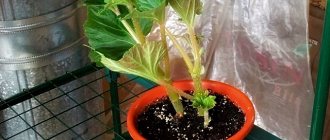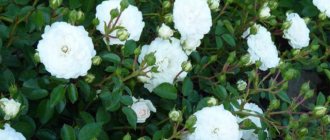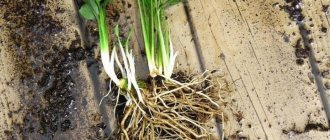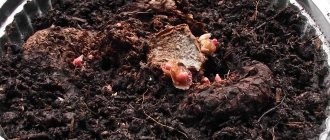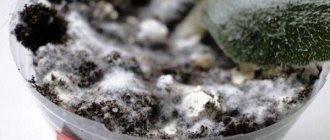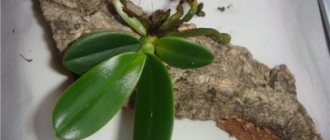The main thing we expect from flowering plants is the beauty of their flowering. But sooner or later this period ends, the buds wither, and only greenery remains.
Does active care for indoor flowers end here? What can be done at this moment so that the plant blooms again next year?
In this article we will analyze in detail the end of flowering, and learn how to properly care for it at this time. We will also look at the difference between tuberous begonia and those with ordinary roots.
general description
This plant is familiar to many, but not everyone knows how many varieties of begonia there are. Let's start with the fact that there are deciduous and ornamental species that are valued for the beauty of their leaves. The color of these plants is simply amazing: red, pink, purple, gray , almost black, various combinations of greenery, with contrasting edging, and a fancy pattern. The leaf shape is irregular, resembling an inverted drop, a circle with a wavy edge, or a maple leaf. The stems are fleshy and thick.
In this article we will talk about another variety - flowering begonia. This plant turned out to be excellent here too: red, yellow, purple, pink and white small flowers literally strew the compact bushes.
The natural habitat of these wonderful flowers is South America, Asia and Africa. They belong to the Begoniaceae family and have more than 1000 varieties. Named after the governor of Haiti, Michel Begon the Elder, who lived in the 17th century, when the begonia genus was discovered.
Reproduction
Begonia is propagated by a variety of methods. To do this, cuttings or dividing the bush are used. This is also done with seeds.
Leaf cuttings
Most varieties of begonia are characterized by large and dense leaves. Therefore, they are propagated by cuttings, using a whole leaf or its fragment. In this case, it is worth cutting the main veins on the underside of the plate, laying it on wet sand and securing it. Moisten the soil through a tray.
After 2 months, roots will appear in the cut areas, and then new plants. When the culture gets stronger, it is moved to a separate container filled with a mixture of peat, soil and sand.
Stem cuttings
This is the simplest way in which the culture propagates. To do this, you should cut cuttings with 3-4 leaves from the plant and treat the cuts with charcoal. Place the material in a mixture of peat, leaf soil and sand. Place in a warm place with sufficient light.
It is recommended to water the crop moderately. Between moistening procedures, the soil should dry out a couple of centimeters. Rooting can be done directly in water. The roots will appear after about 1 month.
Dividing the bush
To implement this method, the plant should be pulled out of the ground in the spring and the roots divided into fragments with a sharp knife. Each of them must contain roots, at least 1 shoot or bud. Plant the shoots in different pots.
Growing from seeds
Seeds should be planted in winter in a special mixture of soil, sand, and peat. To improve seed germination, good lighting, optimal humidity and low air temperature are required.
It is important that the soil does not dry out. Before sprouts appear, the container can be covered with glass.
When seedlings appear, it is worth applying fertilizers containing nitrogen. Grown bushes are moved to separate containers.
When and how long does it bloom?
The duration of flowering depends on several factors:
Plant varieties. Typically, simpler plants bloom longer than their double, large-flowered counterparts.- Care. If the necessary conditions are not provided (temperature, humidity, lighting, soil and pot) and there is no proper care (proper watering, fertilizing, pruning), flowering may be short-lived or not occur at all.
- Growing method. If you plant a plant in open ground, the flowering period will be limited in time due to weather conditions and the need to transplant it indoors. However, some species, such as ever-flowering begonia, after transplanting from open ground into a pot, bloom until spring. Tips for caring for begonias in a pot can be found in a separate article.
- Type of root system. Begonia has species with a tuberous root system and a regular one. The first ones bloom in the summer-autumn period, and the tubers must be dug up for the winter. The latter can bloom almost all year round.
- From the time of awakening. If the plant is dormant, then it all depends on when and how measures to awaken the plant are taken correctly. Usually they start doing this at the end of February. Then by April-May flowers will begin to appear.
You will learn about what to do if a flowering plant does not bloom in this article.
Diseases and pests of begonia
- Quite often, the leaves and petioles of begonia are subject to fungal diseases, most often powdery mildew. In most cases, it is caused by excess moisture. Carefully monitor the condition of the core of the bush, as well as the lower leaves, in order to address the problem in time. These are the places where rot and powdery mildew appear. If, after all, you have diagnosed this problem on your plant, you need to get rid of the damaged leaves and then reduce watering. This way you will be able to avoid the growth of fungus throughout the plant.
- The most common pests for begonias are red spider mites and aphids. To rid your plant of them, you need to generously spray the leaves with a solution of insecticides: Fitoverm, Intavir or Karbofos. After this treatment, you need to place the plant in a damp plastic bag to enhance the effect of the procedure. However, if you carefully care for your begonia, you don’t have to worry about such a problem overtaking you.
Peculiarities
Begonia has flowers of different sexes: there are female flowers with pistils, and male flowers with stamens. How to tell them apart:
- On the back side of the flower, female flowers have a bulge - the future seed capsule; male flowers have nothing there.
- Double flowers in the corresponding species can only be male; female flowers cannot be double. But male flowers, at the same time, can be simple.
- If you understand what pistils and stamens look like, you can simply see them. By the way, some double male flowers may have no stamens at all. It is the modified stamens that make the flower double.
Interesting fact! Removing female flowers from their very formation can significantly increase the flowering period of begonias, as well as increase its intensity. But only if you don't want to get seeds.
Plant during flowering
From the moment it awakens, the plant begins to accumulate strength and nutrients for the upcoming flowering.
Buds are laid and reproductive organs are formed. When the begonia is ready to reproduce, first the male and then the female flowers bloom. If pollination occurs, which is done by hand, then the male flowers wither, and in the female flower a fruit-box with seeds begins to ripen. This is the time of the highest activity of the plant.
At this time, a huge amount of nutrients and microelements is consumed. An accelerated metabolism requires more water, sunlight and heat.
Propagation of tuberous begonia
There are several options for propagating tuberous begonia. This can be done by seed, dividing tubers or cuttings.
Growing tuberous begonia from seeds
This propagation method allows you to preserve the varietal characteristics of the plant. The growing process itself is long and labor-intensive. Seeds should be scattered on damp soil and covered with polyethylene. Place the container in a sunny place and spray it with water daily. Once a day, open the pot for an hour. If this is not done, the seeds may begin to rot from dampness. The optimal room temperature is 24 degrees.
The seeds should sprout in 2 weeks. When the sprouts have 2-3 leaves, they can be placed in cups.
Tuber division
For division, it is best to take old tubers. It is recommended to carry it out in early spring. Until the sprouts reach 4–5 cm, the tuber can be divided into several parts without damaging the plant itself. The cut areas are treated with charcoal powder or a special preparation.
After dividing, parts of the tubers are placed in different pots. Next, they need to be cared for as full-fledged plants.
Propagation of tuberous begonia by cuttings
Cuttings are the fastest and easiest method of plant propagation. You will need a shoot 10 cm long with several leaves. The cut is sprinkled with charcoal powder. Rooting should be done in moist soil in a bright and warm place. The soil should not touch the leaves of the cutting.
The planted cuttings are covered with a jar and ventilated daily. After 3 weeks it can be transplanted into a pot.
What to do next with wilted buds?
Even during the period of active flowering, all faded buds are removed. Some carefully cut, others twist. This way you will gradually remove the entire flowering part, and by the end of flowering the question will disappear by itself. Why do this? During flowering in this way, you save the plant's energy for more luxuriant flowering. At the end of this period, you also help the plant get rid of unnecessary things in order to prepare for dormancy. And in the end, wilted flowers are not aesthetically pleasing; they spoil the appearance of the begonia, making it sloppy and unkempt.
For this purpose, the largest and healthiest fruits are left, the rest are cut off. 20-25 days after flowering ends, the capsule ripens. It is opened and the seeds are taken away. From these seeds you can grow new young plants using seedlings.
Kinds:
There are many types of begonias for home growing. These are various decorative deciduous, decorative flowering, tuberous begonias. Separately, it is necessary to highlight Begonia Elatior.
Flowering indoor begonia
How and when does Begonia bloom?
Amazing beauty pleases the eye when begonia blooms brightly and abundantly enough . Its luxurious flowers resemble buds of a rose, carnation or peony. They are simple and double , large and small , collected in racemose axillary inflorescences formed at the tips of the shoots. The perianth consists of 2-5, and in some species - 6-8 petals. The color scheme varies from white, yellow, pink, red to all sorts of transitional shades, two-tone with a border of flowers, providing a unique holiday atmosphere around you.
The many faces of elegant buds decorate your room from early June until September or from late spring to late autumn, depending on proper care.
Flowering period
The stage of active growth and flowering of the plant requires feeding at least once a week with complex mineral fertilizer. In this case, first a weak solution of potassium nitrate is added, and then everything else.
Begonia dormant period
At the end of flowering, the plant is prepared for the resting phase, gradually reducing the amount of watering until its above-ground part finally dries out. We remove everything that has dried , put the pot in a cool place, watering it occasionally. The temperature should not be higher than 10-12 degrees. The dormant period will last from November to March.
Begonia scent
Among the variety of plant varieties, there are both odorless and fragrant (Bauman's begonia).
Its smell is unique and even has medicinal properties . The invisible influence of begonia helps cleanse the bronchi, increases the vitality of the respiratory tract, and in itself is an excellent natural filter for people with nicotine addiction.
Recreating the microclimate for begonias
Creating a tropical forest microclimate on a home windowsill is a completely feasible task even for novice gardeners.
It is important to remember the basic requirements, the fulfillment of which contributes to obtaining a harmonious flowering specimen:
- Lighting for begonias;
- Air temperature and humidity;
- Optimal watering regime.
The tropical climate is characterized by constant temperature and humidity. Begonias with pubescent leaves grow in the diffuse shade of tall trees, which prevents water from getting on the leaf blades and flowers. Tropical understory plants are exposed to the rays of the rising and setting sun. In the midday heat, begonia leaves are protected by the shade of trees.
Creating similar conditions at home will not be difficult if you place a flowerpot with a plant on windows facing east or west. Otherwise, the plants are shaded from the burning rays of the sun. Begonias are able to grow on the windowsills of northern windows without entering the flowering phase.
Incorrect lighting of begonias most often leads to:
- Sunburn of leaves:
- Formation of petioles that are too long;
- Lack of plant flowering.
The presence of one of the above symptoms indicates the need to change the lighting regime of the herbaceous bush. The problem is solved by shading the begonia on the south window and organizing artificial lighting in a room with a north orientation.
The optimal air temperature range for begonias is +22+24°C during the period of active growth and +19+22°C during the resting phase. Favorable humidity level is 60-70%
Particular attention should be paid to air humidification during the heating season.
Moisture that gets on the developing buds or flowers causes irreparable harm to the flowering of the indoor plant. Sudden changes in air temperature are a stress factor for begonias, as are destructive drafts.
The flow of cool air leads to hypothermia of the root system and loss of moisture from the leaf plates.
Dry air is moistened by irrigation from a spray bottle near the flowerpot. A container of water placed in close proximity to the begonia also effectively increases humidity. It is recommended to place a damp cloth on radiators during the winter season. Household air humidifiers have also proven themselves well.
Improper watering of a houseplant can result in begonias not blooming at home. The method of watering begonias depends on their type. Tuberous and root begonias require different watering. Tropical crops react extremely negatively to excessive waterlogging of the substrate and overdrying of the soil in the flowerpot
It is extremely important to remove excess water from the pan to avoid acidification of the soil
Water for irrigation requires preliminary preparation. Tap water must be left to stand for three days in an open container to remove the chlorine it contains. Most city water supplies supply hard water with high levels of salts. This water needs to be boiled for five minutes.
It is important to prevent water from getting on the petioles and leaves of the begonia during watering. Violation of the watering regime most often entails:
Violation of the watering regime most often entails:
- Root rot;
- Spots on leaf blades;
- Dropping flowers and buds;
- Lack of flowering;
- Wilting of leaves.
The presence of one of the above symptoms indicates a violation of the watering regime. Understanding the source of the problem allows you to correctly determine what to do to correct agricultural mistakes.
Specialized retail outlets sell a soil mixture for begonias containing an optimal set of microelements. Young specimens are replanted annually after the flowering phase is completed. Fertilizing should be done depending on the vegetative phase.
Begonias are not fertilized during the dormant period. At the beginning of active growth, a complex of mineral fertilizers with a predominant nitrogen content is applied.
The fertilizer mixture is changed after the begonia has grown a sufficient amount of green mass. Flowering species need a potassium-phosphorus complex to awaken flower buds and maintain the flowering process. The application of fertilizers that do not correspond to the vegetative phase causes a lack of flowering and the formation of too lush greenery.
How does begonia bloom?
What to do after the begonia has bloomed?
After the plant has pleased you with lush flowering, you should definitely dry . We put it in a dark place for a month so that all the nutrients from the stems and roots go into the tuber. We dig it out 15 days after the upper part of the begonia, which is on the surface, has finally died off.
Do I need to prune begonias after flowering?
After completing the flowering stage, the plant needs pruning. At the same time, cut off the stems . This is necessary so that the flower gains strength and nutrients and has the opportunity to thank its owner in the future with a magnificent and fragrant bouquet of double begonia inflorescences.
How to properly store tubers
In winter, begonia tubers can be stored in an apartment or basement. Each of these options has its own nuances.
Storage in the apartment
In an apartment, it is recommended to store flower tubers in a cool place. This could be a place under a window or balcony door. The temperature should be in the range from 0 to 9 degrees.
There are 3 main storage options:
- In a box or crate. The tubers are sprinkled with sand, sawdust or peat.
- In pots. The container is transferred to a cool place, and all the green part is cut off. The soil needs to be watered periodically, it should remain slightly moist.
- In a refrigerator. The tubers are thoroughly dried, placed in bags with holes and wrapped in paper. They are best stored in the bottom of the refrigerator with fruits and vegetables.
When stored in pots there is a risk of rotting. To avoid this, the soil should be watered through a tray.
Basement storage
The basement should be dry and cool. A cellar for storing begonias is not suitable. It contains high humidity and planting material can begin to rot. The tubers are placed in a box or box. They must be covered with sawdust or sand.
Features of caring for begonia after flowering
It is not whimsical, but requires careful care, like any house plant, especially after flowering.
REFERENCE:
- the temperature should reach 18 degrees in winter and 20-25 in summer;
- enough light is needed. The best place is close to the window, but not exposed to direct sunlight;
- water as needed, more often in summer, less often in winter, when the soil dries to a depth of one or two centimeters;
- We use soft, settled water for irrigation;
- We create high air humidity - at least 50-60 percent.
Difficulties in care
- There is no flowering - to flower at home, you must follow all the rules, and if one of them is violated, the begonia will not bloom. There may be insufficient lighting, low humidity, or lack of watering, the temperature is too high, or below 18 degrees.
- The buds are sprinkled at the initial stage of development - lack of fertilizers, too waterlogged, or a dry earthen lump.
- Leaves turn yellow and fall off - insufficiently nutritious soil, lack of moisture, or poor lighting. Another reason is pests that attack the root system. Before replacing the soil, clean the roots from the old substrate and be sure to treat them with a solution of potassium permanganate.
Why doesn't indoor begonia bloom at home?
Reasons why begonia does not bloom
Most likely, it does not have enough light, the humidity is low, the temperature is not suitable, or you left it in a draft and overdid it with fertilizers.
Try to follow the care recommendations, change the location of the flower and the conditions of its maintenance: move it to another window sill or to a room where the temperature is suitable and there are no drafts.
How to make begonia bloom?
To ensure long and abundant flowering, they use the “short daylight” technique : for two weeks, the daylight hours are artificially reduced to 9 hours, covering the begonia with black film. Thus, the process of laying buds is activated. To prevent the plant from accelerating its growth in height at this time, it can be pinched 2-3 times. Then daylight hours double again. During the winter months, lighting is also necessary.
Compliance with the above rules of care will allow you to enjoy the luxurious beauty of flowering and enchanting aroma for as long as possible.
Take care of the begonia and take care of it, then the flower will bloom buds and smell, pleasing your eyes and smell!
Next you will see a photo of a blooming Begonia:
What is necessary?
Before proceeding directly to transplanting begonias, it is important to stock up on all the necessary components for this. These include several components
- Pot. It should not be too large and spacious. For young plants, you need to select containers 3-4 centimeters larger than the previous pots in which they are sold in stores.
- High-quality and suitable soil mixture. For begonia, the optimal mixture is a combination of peat, humus, turf and plain soil. All components must be taken in equal proportions.
- Good drainage. You should never forget about it if you want to create the most comfortable living conditions for the plant. For this purpose, various materials are used, for example, expanded clay, tiles, crushed stone or polystyrene foam cut into cubes.
These are all the necessary components that will be needed to properly transplant the begonia into a new container.
Useful video
In these videos you can learn more about the flowering of Begonia:
https://youtu.be/Z8aO7IvNyYY
Useful material Below is a list of articles that may be of interest to you.
If you find an error, please select a piece of text and press Ctrl+Enter.
Begonia is a large genus of plants in the Begoniaceae family, including herbs, shrubs and subshrubs.
How long do begonias bloom? Expressive flowering of plants awaits caring gardeners and owners of indoor flowers. Activity can last up to 6-12 months, after which the plant requires rest to restore and accumulate organic matter. The appearance of buds is also influenced by the plant variety (there are varieties that bloom at certain times of the year and bloom all year round), the choice of soil and other care elements.
Begonia propagation by leaf.
1 way.
Begonias have fairly large and dense leaf plates that can be used for propagation. Both the entire leaf and part of the leaf can produce babies after rooting. The leaf is chosen to be dense and without damage; on its back side, on the main veins, cuts must be made at intervals of 2 cm. The substrate for rooting must be special; additional sand or vermiculite can be added to it. It is advisable to treat the begonia leaf and substrate with a solution of phytosporin, which will prevent the leaf from rotting.
After this, the begonia leaf with cut veins is placed on the substrate, pressed well and fixed in this position, for example, with something that can serve as weights. A greenhouse is installed above the leaf; watering is carried out only through a tray or from a spray bottle. Place the container with the leaf in a warm (24°C) and slightly shaded place.
On average, after 2 months the leaf takes root, roots appear exactly from those places on the vein that were cut. Later, children appear, which are separated from the leaf when they get stronger and planted in separate pots.
Begonia Escargot.
Method 2.
Begonia can also be propagated by a leaf with a petiole, which is rooted in settled water with the addition of activated carbon. The leaf should be healthy, dense, with a petiole no more than 3-4 cm.
The condition of the leaf and the water level must be constantly monitored. Water must be added regularly, and at the slightest signs of rot on the leaf petiole, measures must be taken: change the water, adding a new tablet of activated carbon, cut off the cut, dry it, crush it with crushed activated carbon and put it back into the water. The begonia leaf is planted in the substrate when the roots reach 2 cm.
Plant varieties
What kind of begonias bloom? When studying varieties of plant crops, you can come across several classifications that allow you to more accurately determine the characteristics of a particular variety.
According to decorative properties, the following types are conventionally distinguished:
- decorative - deciduous;
- shrubby;
- tuberous;
- beautifully flowering.
Despite the abundance of colors and variants of shoot shapes, deciduous varieties are characterized by the appearance of small flowers, while flowering varieties can delight with the appearance of inflorescences of various sizes and shades.
Depending on the biorhythm, potted or growing plant crops need special care and conditions for planting and development.
Most varieties bloom at a certain age. This fact should be taken into account when purchasing small bushes with abundant flowering; as a rule, in such cases, specialized preparations were used in relation to the flower, provoking the appearance of buds ahead of schedule. Despite the number of inflorescences, the plant's activity quickly fades away, after which a long period of dormancy begins.
Popular varieties of begonias and their flowering times
How to determine how long indoor or garden begonia will bloom? The flower has many (more than one and a half thousand) varieties, but only 125 of them are grown to decorate the garden and the interior of the house. Also, for landscaping, various plant hybrids are grown, obtained through the hard work of gardeners.
The most common varieties and varieties of garden and house flowers:
Conditional view
Possible forms
Variety
Flowering time
Proper home planting by shoots and other methods
There are a huge number of ways to propagate begonias:
- seeds;
- cuttings;
- leaves;
- tubers;
- rhizomes;
- lateral processes (children);
- dividing the bush.
Regardless of the chosen method, you need to remember that planting is best done in the spring, because it is during this period that the young plant has the best chance of successfully rooting. For the first planting, it is better to choose small containers with a diameter of up to 10 cm.
Despite the fact that adult begonias feel better in ceramic pots, a plastic one is quite suitable for a young plant, since in less than a year, if rooting is successful, it will have to be replanted. You need to understand that a young plant is much more fragile than its adult relatives, so it needs to create optimal conditions. This can be done using a polyethylene greenhouse, in which elevated temperature and humidity will be constantly maintained.
Important! Begonias do not tolerate low temperatures well (the minimum permissible value is +15 degrees), but overheating is no less destructive for them. The temperature in the greenhouse should not exceed +28 degrees, otherwise it can cause irreparable harm to the plant.
Growing from a tuber
In autumn, the tubers should be removed from the ground, cleaned and stored all winter in sand or peat at a temperature of about 10 degrees. In February, the tubers must be planted in pots with moderate watering.
If you don’t have your own planting material, you can purchase it at the store. You need to choose tubers that have small sprouts.
Germination of tubers
Place the purchased tubers in a warm place in the light on a damp cloth and wait for small roots to appear and plant them in pots. The thickness of the soil above the tuber should be about 2 cm.
When the threat of frost has passed, begonias and pots can be planted in a flowerbed.
With the arrival of the first frost, flower pots should be moved indoors, the stems removed, and the pots should be placed in a cool place until spring and under no circumstances should they be watered.
Germination in a pot
When the first sprout appears from the pot in early spring, you need to lightly clean the tuber from the soil. This will make it easier for it to germinate.
You can also do this. The tuber needs to be cleared of old roots and planted in pots. We place the pots in the light and water them regularly. It is not advisable to cover the top of the tuber with soil. After 1.5-3 weeks it will sprout.
Tuber propagation
To increase the amount of planting material, the tuber can be divided into pieces. This is done when the sprouts grow to 5 cm. Then the cut areas should be sprinkled with crushed coal, dried, placed in pots again and wait for new sprouts.
Now we’ll tell you how to grow begonia from seeds.
Hybrids of flowering begonias
These begonias are quite diverse, differing in the size and shape of the bush, the shape of the inflorescences, and there are differences in care. Hybrids of flowering begonias are grouped into separate groups:
Coral begonia Begonia x 'Corallina de Lucerna' is a hybrid begonia obtained from crossing Begonia teuscheri x Begonia coccinea.
A large bushy plant with erect stems. The leaves are elongated-ovate, pointed at the end, with a serrated edge, up to 15 cm long. The surface of the leaf is green with white inclusions or spots, the reverse side has a reddish tint. The flowers are bright pink and collected in multi-flowered inflorescences. This hybrid usually belongs to the decorative-deciduous begonias, but sometimes it blooms so profusely and for a long time that it would be more correct to classify it in both groups, including the decorative-flowering ones.
Begonias of the Lorraine group Begonia x Lorrain (Begonia hybrida Gloire de Lorraine) are a group of hybrids.
Plants form small bushes up to 50 cm tall, with thin, slightly drooping stems. The leaves are round in shape, wavy along the edge, up to 10 cm in diameter. The leaf surface is green or dark green. The flowers are about 2.5 cm in diameter, on short peduncles in loose panicles, simple (not double), usually pink with various shades and white. The main flowering occurs in autumn - early winter. They often bloom for the New Year and Christmas.
Begonias of the Elatior group Begonia x Elatior are a group of hybrids.
Plants form small bushes up to 35 cm tall. The leaves are round in shape (pointed in some varieties), jagged along the edge, up to 10 cm in diameter on reddish thin stems. The leaf surface is green. The species is similar to the previous one, but the flowers are larger, about 5 cm in diameter, on short peduncles in loose panicles. The flower shape is often double or semi-double. Some flowers have smooth petal edges, others have jagged edges, and still others have slightly jagged edges. Flower colors are common: white, pink, coral, scarlet, peach, yellow, orange, etc. Flowering - at any time of the year.
Tuberous begonia Begonia x tuberhybrida is a group of complex hybrids that includes several subgroups.
It is distinguished by the presence of a fleshy underground tuber-rhizome. The height of the bush varies in some subgroups about 30 cm, in others 80-90 cm. Subgroups of tuberous begonias are classified according to flower size and shape: small flowers, medium flowers, large flowers, single flowers, semi-double flowers and double flowers. The shape of the leaves is also somewhat different, but they are all on short petioles, asymmetrical, pointed at the end, usually with a serrated edge. But this group of real flowering begonias, the whole beauty of this group is in the abundant and beautiful flowering. Flowers can be any color - white, pink, salmon, red, purple, orange, yellow, etc., except for purple and blue shades.
Species flowering begonias
Bright red begonia Begonia coccinea is a large, slightly branched bush-like plant with erect stems, the average height of the bush is 1.5 m, but can be higher, while the shoots begin to droop from their own weight and require support. Some of the stems of old tub plants become bare at the bottom. The leaves are elongated-ovate, with a wavy edge about 12 cm long on short petioles. The surface of the leaf is smooth and shiny, light green in color, without spots, the reverse side and edge of the leaf have a reddish tint. Bright red or pink flowers are collected in panicle inflorescences.
Begonia glaucophylla is a bushy, well-branched plant, reaching 1 m in height. The shoots are initially erect, then drooping. Over time, the plant takes on an ampelous shape and is grown in hanging pots. The leaves are ovoid, pointed at the end, with a slightly wavy edge, up to 12 cm long, on short petioles. The leaf surface is smooth, bright green, without spots. Red (coral and red-pink) flowers, about 1.5 cm in diameter, are collected in a raceme inflorescence. Synonyms: Begonia limmingheana (limmingheiana), Begonia radicans, Begonia procumbens. It blooms readily and easily if the soil is sufficiently nutritious, and blooms for a long time, mainly in the summer months.
Ever-flowering begonia Begonia semperflorens is a small bush-like plant, shoots reach about 60 cm in length. In a young bush they are erect, then they droop, and the adult plant has a semi-ampeloid or ampelous shape. The leaves are round in shape, slightly pubescent along the edges, up to 6 cm long. The leaf surface is light green, but can be dark green and with a reddish tint. The flowers are collected in a loose panicle on a short peduncle. Flowers can be single or double, up to 2.5 cm in diameter, white, pink or red. It is characterized by long flowering, the inflorescences themselves are short-lived, they fade faster in hot weather, but new buds immediately bloom to replace the faded ones. Peak flowering occurs in the summer and autumn months. It can continue to bloom in winter, especially if there is enough light and nutrients.
